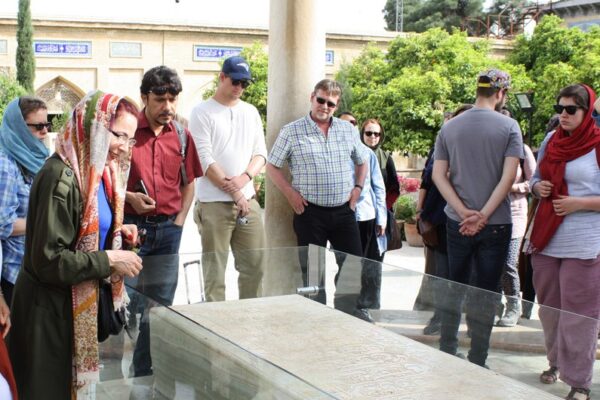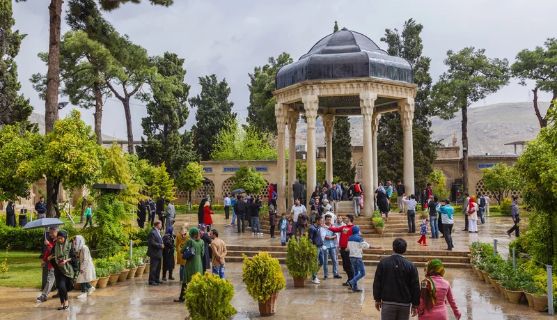BIOGRAPHY
Hafez, also spelled Hafiz, in full Shams al-Din Muhammad Hafiz is one of the most well-known poets of Iran, who was born in Shiraz in 1315 and passed away 65 years later. His collected works are regarded as a pinnacle of Persian literature and are often found in the homes of every Iranian.
EDUCATION
Hafez received a classical religious education, lectured on Quranic and other theological subjects (“Hafez” designates one who has learned the Quran by heart), and wrote commentaries on religious classics. As a court poet, he enjoyed the support of several rulers of Shiraz.
About 1368–69 Hafez fell out of favor at the court and did not regain his position until 20 years later, just before his death. In his poetry there are many reflections of historical events as well as biographical descriptions and details of life in Shiraz. One of the guiding principles of his life was Sufism, the Islamic mystical movement that demanded of its adherent’s complete devotion to the pursuit of union with the ultimate reality.
POEMS
Hafez’s principal verse form, one that he brought to a perfection never achieved before, was the ghazal, a lyric poem of 6 to 15 couplets linked by unity of subject and symbolism rather than by a logical sequence of ideas. Traditionally, the ghazal had transaction with love and wine, in their association with ecstasy and freedom from restraint, lent themselves naturally to the expression of Sufi ideas. Hafez’s achievement was to give these conventional subjects a freshness and subtlety that completely relieves his poetry of tedious formalism. An important innovation credited to Hafez was the use of the ghazal instead of the qaṣīdah in salutation. Hafez also decrease the panegyric factor of his poems to a mere one or two lines, leaving the remainder of the poem for his ideas. The extraordinary popularity of Hafez’s poetry in all Persian-speaking lands stems from his simple and often demotic though musical language, free from artificial virtuosity, and his unaffected use of homely images and proverbial expressions. Above all, his poetry is characterized by love of humanity, contempt for hypocrisy and mediocrity, and an ability to universalize everyday experience and to relate it to the mystic’s unending search for union with God.
History of Hafezieh
Hafez died in 1390, and in his memory, a small, dome-like structure was erected in Shiraz near his grave at Golgast-e Mosalla in 1452 at the order of Babur Ibn-Baysunkur, a Timurid governor. The Golgast-e Mosalla were gardens (now known as Musalla Gardens) that featured in Hafiz’s poetry. The garden covers an area of 19,000 square meters, which is aShah Abbas I, and Nader Shah both carried out separate restoration projects in the following 300 years
A much more substantial memorial was constructed in the gardens in 1773 during the reign of Karim Khan Zand. Situated on the north bank of the seasonal Rudkhaneye Khoshk River in the Musalla Gardens.
The tomb was restored in 1857 by a governor of Fars, and a wooden enclosure was built around the tomb in 1878, by another governor of Fars. Following this, the site became a subject of controversy, when, in 1899, Ardeshir, a Parsi from India began to build a shrine around Hafez’s grave.
In 1901, Prince Malek Mansur Mirza Shao es-Saltaneh placed a decorative iron transenna around Hafez’s tomb.
After several renovations, destructions, and constructions during history, finally, the current pavilion structure was built in 1935. It is designed by the well-known French architect and archaeologist, André Godard using Zandieh architecture elements.
Architecture of Hafezieh
The tomb of Hafiz also known as Hafezieh is located north of Shiraz and comprises of two gardens.
The Hafezieh consisted of four central columns, with two rooms built at the east and west end and with the north and south sides remaining open. The building split the gardens into two regions, with the orange grove in the front and the cemetery in the back.
The original, four-columned memorial hall built in 1773 by Karim Khan Zand was extensively expanded. Sixteen pillars were added to the four original, creating a long verandah, and on several facades are engraved ghazals and other excerpts from Hafez’s poetry.
The mausoleum includes two parts: the orange grove in the front and the tombstone in the back with a marble slab placed over the grave. Elevating one meter above ground level and encircling with five steps, the marble tombstone consists of eight columns, supporting a copper dome made of enameled tile mosaic in the shape of a dervish’s hat.
Beautifully inscribed with two of Hafez’s poems or Ghazals, the tombstone has been attracting visitors for centuries to pay homage to this spiritually rich poet and to take the omens or faals by picking a page randomly from a volume of Hafez, kept for this purpose.

HAFEZ IN CEREMONIES
Many Iranians use Divan of Hafez for fortune telling. Iranian families usually have a Divan of Hafez in their house, and when they have gatherings during the Nowruz or Yalda holidays,they open the Divan to a random page and read the poem on it, which they believe to be an indication of things that will happen in the future.



Comment (0)